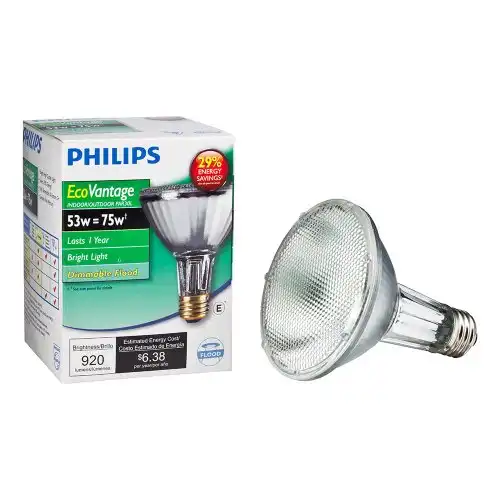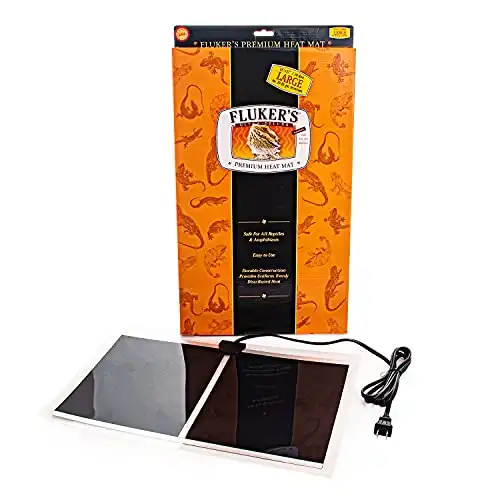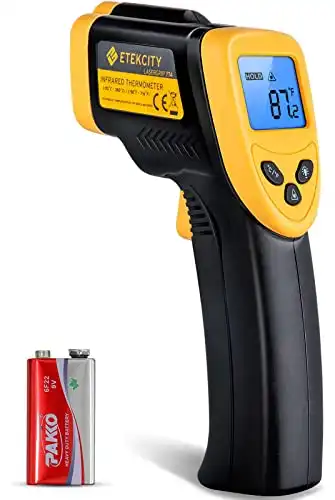Heating set-ups for leopard geckos can be really tricky to figure out. You could spend a lot of money on all the necessary devices but still have bad tank temps. But don’t worry—it’s not impossible to find the best heating set-up for your gecko’s tank if you know the basics!
In general, the best heating set-up for leopard geckos consists of a 1) halogen for primary heating, 2) carbon heat projector for secondary heating, 3) dimming thermostat, 4) ambient thermometers, and a 5) temperature gun. It is also recommended to have a power bank in case of emergencies and power outages.
Creating the best heating set-up for leopard geckos is so much more than finding the best choice of heat source for our lovely little leos. Having equipment that accurately monitors and reliably controls the heat produced by heat lamps is just as important.
Continue reading below to find out why!
1. Heat Source (Primary and Secondary)
In most cases, leopard geckos need one primary heat source during the day and one secondary or supplemental heat source during the night. Halogen heat lamps and carbon heat projectors are recommended for primary and secondary heating, respectively.
Contrary to popular belief, heat lamps (interchangeably used with basking lights, daylight floodlights) marketed as “infrared lamps” are not the only type of lamps that can produce heat.
In fact, all lighting elements will produce some amount of heat. This is why even LED lights can still be warm or hot to the touch if you directly grab onto it after it has been. However, this doesn’t mean that all types of light bulbs can be used to keep our adorable leopard geckos snug and toasty.
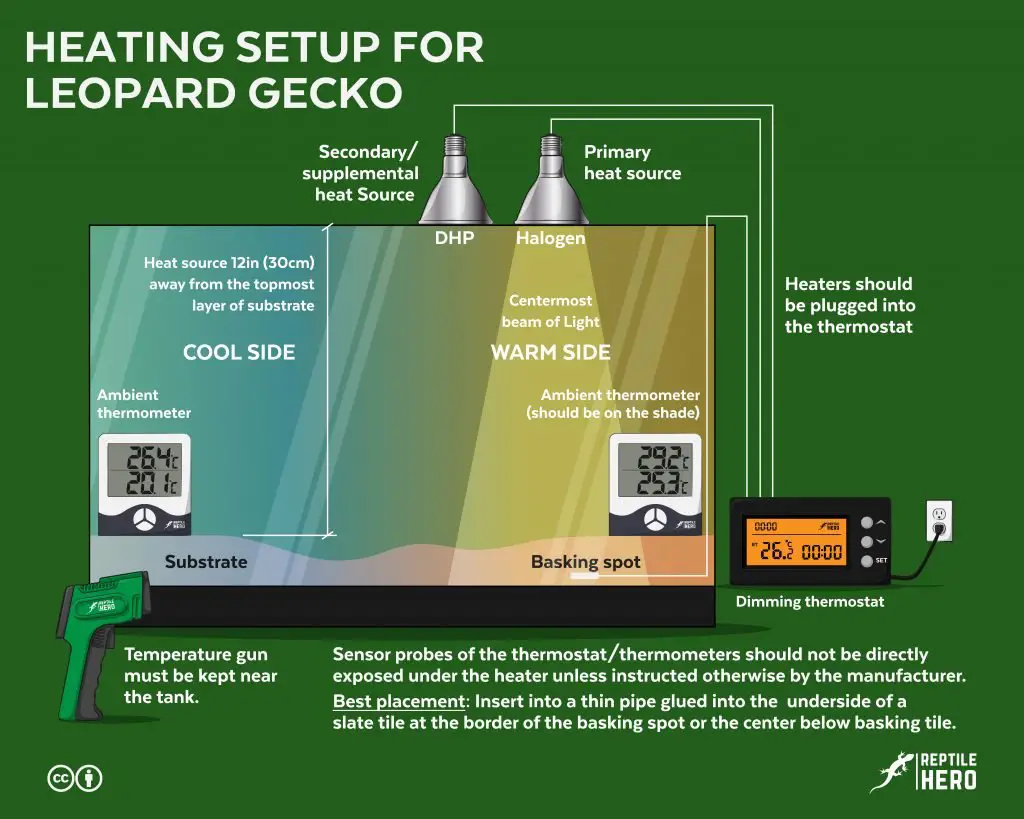
Out of all the choices out there, 4 heat sources are considered good and safe for leopard gecko tanks:
- Halogen heat lamp
- Carbon heat projector
- Ceramic heat emitter
- Heat mat
Even though every single option functions as a heater, they vary in terms of the quality of the infrared they give off—among many other factors.
| Factors for Heat Source Selection | Halogen Heat Lamp | Carbon Heat Projector | Ceramic Heat Emitter | Heat Mat |
| Function | Heating Lighting | Heating | Heating | Heating |
| Heat Produced* | Infrared B Infrared A Infrared C | Infrared B Infrared C Infrared A | Infrared C Infrared B | Infrared C |
| Temperature Control | Dimming thermostat | Dimming thermostat | Pulse-Proportional thermostat | On/Off or Pulse-Proportional thermostat |
| Power Rating | 30–100 Watts | 50–100 Watts | 25–250 Watts | 10–60 Watts |
| Life Span | ± 6 Months | 2–6 Years | ±6 years | 6+ Years |
| Usage Time | 12–14 hours/day | 10–24 hours/day | 10–24 hours/day | 10–24 hours/day |
| Safety of Use | Fire Thermal Burn | Fire Thermal Burn | Fire Thermal Burn | Fire Thermal Burn |
| Price Range | ± 10 USD | 20–40 USD | 10–20 USD | 10+ USD |
| Set-Up Compatibility | Versatile | Versatile | Versatile | Limited |
| Position | 12 in (30 cm) above the substrate | 12 in (30 cm) above the substrate | 12 in (30 cm) above the substrate | 0.39 in (1 cm) below the substrate |
| Installation | Requires fixtures and accessories | Requires fixtures and accessories | Requires fixtures and accessories | No fixtures and accessories required |
1. Halogen Heat Lamp
Halogen bulbs are the most commonly used heat lamp option for leopard geckos nowadays. Halogen heat lamps provide both significant levels of heat and light. This makes them the ideal primary heat source for leopard geckos during the day.
Technically speaking, halogen bulbs are also considered incandescent bulbs as they have the same basic component and produce both light and heat through incandescence. But unlike the old-fashioned incandescent, halogens produce much more heat and whiter light.
This is achievable because the capsule where the filament is housed does not have only inert gasses but also halogen components (e.g., iodine). Because of this addition, they also have a much longer life span—making them the popular choice among gecko parents.
Lighting and Heating
Out of the 4 common choices for leopard gecko tank heating, only halogens produce significant amounts of both light and heat, making it the most sun-like heat source.
More specifically, the average halogen also gives off a warm light at 3000 Kelvin (K). This light has a wavelength that peaks around the 800-nanometer (nm) or near-infrared (IR-A) range of the electromagnetic spectrum. Perfect for deep-penetrating warmth!
Learn more about the different types of infrared radiation in our article on leopard geckos and heat lamps.
Halogens With Infrared and Ultraviolet
A few reptile-specific halogen heat lamps are advertised to also emit ultraviolet A and B. However, many of these produce lethally high levels of heat and UV in a tiny patch of light and do not have protective glass covers.
Conversely, some don’t even produce a smidgen of measurable UV.
So unless such products have been thoroughly and independently tested by long-time pet parents and herpetologists, it’s better to stick with household halogen lamps.
How to Find the Best Halogen Heat Lamp for Gecko Tanks
Familiarize yourself with how to properly choose a halogen lamp for your cute soft-scaled leopard geckos. Different brands offer halogens with a variety of shapes, sizes, bases, power rating, brightness, color output, lifespan, and what have you.
Don’t have the time—and money—to test out different widely available halogen bulbs on your own? I’ve got your back!
The Reptile Hero team and I recommend is the one below. It is the best primary heat source for your leopard gecko during the day.
2. Carbon Heat Projector
Carbon infrared heaters, also known as deep heat projectors (DHP), are the perfect choice for a secondary heat source for leopard geckos during the day. They are also great for supplemental heating in the tank during cooler nights.
Much like halogens, carbon heat projectors produce a significant amount of deeply penetrating thermal radiation (infrared B and A). However, carbon heaters neither produce bright light nor project sun-like heating.
In reality, the heat output of deep heat projectors is primarily composed of infrared B, a good amount of infrared C, and very little infrared A. So contrary to the claims of a few keepers and breeders, carbon heat lamps are not a good alternative for halogens.
Perfect for Really Cold Weather
On the brighter side of things, these drawbacks can actually benefit gecko owners living far up north! Keepers and breeders living in New York—even as far as Canada—can attest to this.
Having a deep heat projector working alongside a halogen helps boost overall tank temperatures during the day. It also helps with making sure that no gecko freezes over during really chilly nights.
Limited Options Available
Despite its popularity within the reptile-keeping community, very few reputable companies have come out to offer their models. Sure, it’s quite easy to find “new” dirt-cheap units in online stores and platforms, but these are not generally very bad in terms of overall quality.
To this day, I still highly recommend Arcadia’s 50W Deep Heat Projector (here at Pangea Reptile) for supplemental heating in leopard gecko tanks.
3. Ceramic Heat Emitter
Ceramic heat emitters can be used for nighttime supplemental heating in leopard gecko tanks. They are not suitable as primary heat sources because they largely produce infrared C with negligible amounts of infrared B.
Although they can’t warm up our geckos thoroughly, ceramic heaters can still help a lot with boosting ambient temperatures within your precious leopard gecko’s tank—by up to 20ºF.
Unlike halogens and deep heat projectors, ceramic heaters don’t produce any visible light at all. This means that you can use them in your gecko tanks all day long without disturbing your scaly baby’s sleep-wake cycle!
Learn more about the differences and similarities between halogen heat lamps and ceramic heat emitters in our article discussing ceramic heater vs halogen.
Which Ceramic Heater Should You Get for Your Gecko Tank?
Generally, you would only need to look at 3 factors to find the perfect ceramic heater for your pet and its enclosure: 1) overall design, 2) power rating, and 3) life span.
However, if you don’t have time to spare in searching for the best ceramic heat emitter your money can buy, then hear us out.
My team and I have worked with several experts to find out which ceramic heater is the best option for leopard geckos. After our detailed assessment, Fluker’s Ceramic Heat Emitter came out on top.
4. Heat Mat
Compared to halogens, carbon projectors, and ceramic heaters, heat mats are less efficient heat sources for leopard gecko tanks. However, heating pads are still useful options for supplemental, emergency, and/or temporary heating.
A couple of years ago, heat mats were all the rage in the reptile-keeping community. The myth of leopard geckos only being able to absorb warmth through their bellies is the main culprit behind this phenomenon.
However, as more and more leopard gecko owners pushed for advancing husbandry many realized that heat mats weren’t the best choice for heating.
Learn more about why halogens are better than heat pads in our article on heat lamps vs heat mats.
When to Use a Heat Mat for Leopard Geckos
Now don’t get me wrong. I’m not saying that heat mats are useless devices. The point that I’m trying to get across is that heat mats are best reserved for temporary use.
During a blackout, for example, plugging in a couple of heat mats into a power bank will keep your leos warm for much longer than having to power up a complete heating set-up. In short, it’s an energy-efficient choice for heating.
Keep in mind: A heat mat should cover half or a third of your gecko tank’s floor area for it to effectively raise ambient temps.
Find the Right Heat Mat for Your Gecko
Choosing the right heat mat can be quite the chore though. If you agree, then I might just be able to help you. Previously, I tested out multiple mats with the help of the rest of the Reptile Hero team and other friends in the reptile community.
The top recommendation for leopard gecko tanks is Fluker below.
Can You Use Heat Rocks as Your Gecko’s Heat Source?
Heat rocks for geckos and other reptiles are neither a good nor a safe heat source. Numerous cases of severe thermal burns in leopard geckos, bearded dragons, and snakes have been attributed to heat rocks.
Although heat rocks can indeed produce some warmth, it is not a good or safe option for a leopard gecko’s primary or secondary heat source.
Interestingly, I have seen a few experts within the reptile-keeping community create their own “heat rock slab” using heat mats.
But since that requires a lot of experience with electronics among many things, I don’t recommend beginners or even experienced leopard gecko owners to attempt anything similar.
Let’s just stick to the tried, tested, and touted halogen heat lamp.
2. Thermostat
It is crucial for all heat sources used for leopard geckos tanks to be controlled using the appropriate thermostat. This device ensures that geckos and other reptiles are given optimal tank temperatures and that they are maintained at proper levels.
Aside from that, having a thermostat will guarantee that the temps in your leo’s enclosure don’t fluctuate abnormally through the day. Some even have a feature that lets you schedule exactly when and how much a heat source ramps up and down.
The Importance of Correct Probe Placement
For your thermostat to reliably monitor and control your gecko’s tank temps, make sure that its probe sensor is not directly exposed to the direct beam of heat and/or light of your heater.
Doing otherwise would result in inaccurate readings and could make the temps hotter or colder than ideal.
Learn more about proper probe placement in leopard gecko tanks in our article on premium and budget thermostats.
Different Thermostats for Different Heaters
Just remember that not all thermostats will work well with all heating devices. Heat sources that produce light (e.g., halogen, deep heat projector) require dimming thermostats.
In comparison, a bulb-type heater that does not emit any visible light (e.g., ceramic heat emitter) will work efficiently with a pulse-proportional thermostat. Lastly, on/off thermostats can only be used in conjunction with a heat mat.
If you are planning to use a variety of heat sources, a multi-functional thermostat like the Herpstat 2 (here on Spyder Robotics) is the best option.
Note: At the time of writing, this specific model is out of stock. But Herpstat 2 has not been discontinued by the manufacturers. Pricier alternatives include the Herpstat 2 SpyderWeb and the Herpstat 4.
3. Thermometers (Ambient and Surface)
A single leopard gecko heating set-up requires at least 3 thermometers: 1) an ambient thermometer on the warm side of the tank, 2) another ambient thermometer on the cool side, and 3) a non-contact thermometer or temperature gun.
You need at least one ambient thermometer to monitor each side of a leopard gecko tank to check for air temps. Whereas an infrared temp gun is used to check for basking and surface temps.
Both ambient and surface temperature need to be closely monitored so you need both types of thermometers. Neither can be used to replace the other.
Thermometer for Ambient Temperatures
Personally, I would recommend an ambient thermometer that is electronic or digital. For leopard geckos, you wouldn’t really have a problem in terms of humidity. You could pop a thermometer without a corded probe right into the vivarium without any problems.
Of course, you could also go for an analog or dial thermometer if that’s more your style. They aren’t as bad as others claim. Plus, they don’t require batteries or any other power source to work.
Like me, most other breeders and keepers would likely recommend the Govee Indoor Smart Thermo-Hygrometer. This nifty little digital thermometer also doubles as a hygrometer so you get more bang for your buck.
Thermometer for Surface Temperatures
Regular thermometers are not designed to accurately gauge the surface temperature of decors, furnishings, and everything else inside your gecko’s tank.
But the good thing about this equipment is that you only really need one regardless of how many reptiles you have in your family. It doesn’t matter if they have different temperature requirements either.
Most temp guns are designed to measure temperatures well below and above the thermal needs of most geckos and virtually any other reptile.
I highly recommend the Lasegrip. It’s probably the most widely used model in the reptile community.
What is the Ideal Tank Temperature for Geckos?
For leopard gecko tanks, the cool side must maintain an ambient temperature of 70–80°F (21.11–26.66°C). Conversely, the warm side must have an ambient temperature within the 85–90°F (29.44–32.22°C) range. The surface temperature for the basking spot should be kept at 95–100°F (35.00-37.77°C).
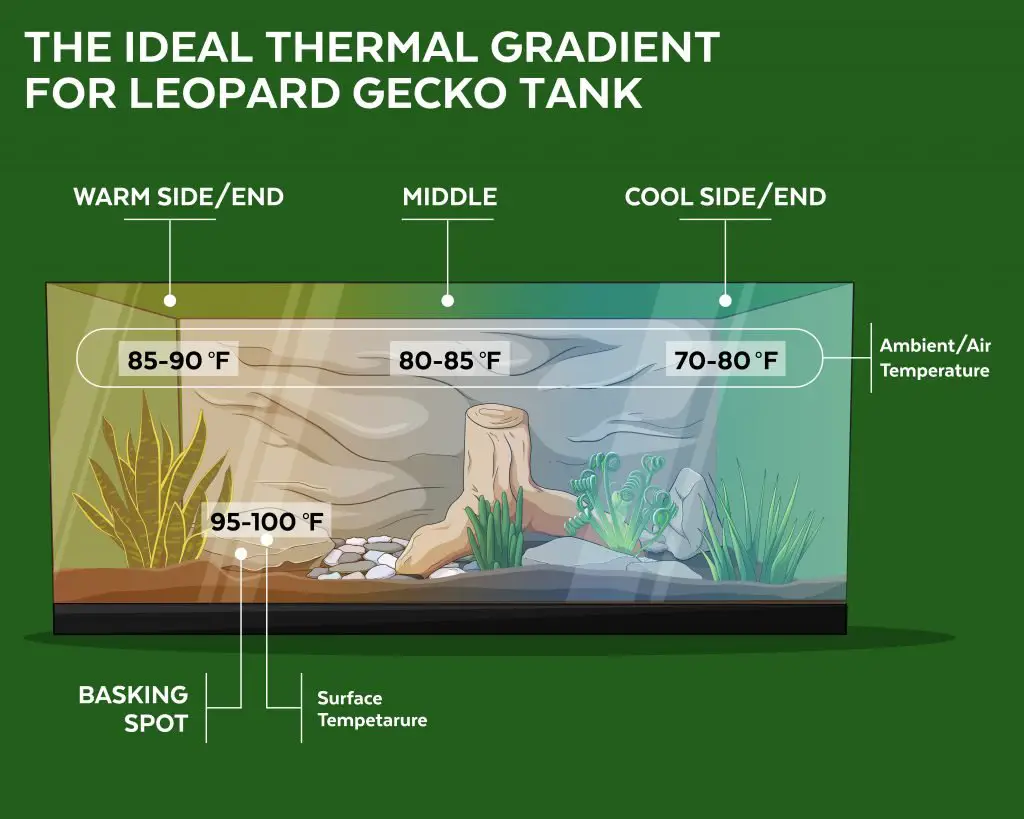
Ideally, leopard geckos must have a thermal gradient of 70–90°F (21.11–32.22°C) during the day and 65–75°F (18.33–23.88°C) during the night [1].
Temperatures normally fluctuate all through the day. It’s hotter during the day, and cooler at night. Changes in temperature signal the time of the day to geckos. As such, it’s important to give leopard geckos and other reptiles temp drops at night.
The aforementioned temperature gradients can be maintained throughout the year if you don’t have plans of breeding your leopard geckos or inducing brumation in captivity.
Do Leopard Geckos Need Heat During the Night?
In the wild, leopard geckos normally experience a daily drop in temperature when night comes. Nighttime temperatures for leopard geckos can dip to 65°F (18.33°C). In cases where night temps drop way below that point (e.g., 50°F or 10°C), nighttime heating is recommended.
Can Leopard Geckos Overheat?
Leopard geckos can experience overheating, and even heat stroke, if they are exposed to ambient temperatures above 90ºF (32.22ºC) for prolonged periods in an enclosed space.
Overheating can have fatal consequences for our leopard geckos. So it is important to keep their thermal needs in mind when designing and creating the heating set-up for their tanks.
Below are some helpful tips to prevent your geckos from overheating:
- Provide a tank long enough to create a cool side
- Keep an eye on tank temperatures using thermometers
- Manage all heat sources with the right thermostat
- Install overhead heaters at least 12 in (30 cm) from the
- Don’t place the tank near windows that receive a lot of sunlight
- Always have fresh water in their tanks for hydration
- Keep the heat source out of their reach
- Provide them with plenty of shade and hides
- Make sure that the tank is well ventilated
- Regularly mist the tank
If you suspect that your leopard gecko is overheating, do not attempt to cool them down immediately. Doing so will cause them to go into shock. Instead, get in touch with your exotic veterinarian immediately and go for an emergency consultation if possible.
How Do I Keep My Leopard Gecko Heated During a Power Outage?
As a precautionary measure, it is highly advisable for leopard gecko keepers and breeders to have an alternative or backup power source, such as a portable power station, to keep tank heaters running.
Not gonna lie, power banks are pretty pricey devices! Nonetheless, they are a good investment for both beginner and experienced leopard gecko owners.
I would even argue that power banks are becoming more and more indispensable when it comes to reptile husbandry, especially considering how unpredictable the weather has been these past years. We have also faced a number of unforeseeable events.
Learn more about how to prepare for blackouts and emergencies in our articles on gecko care during power outages.
So keepers and breeders should make it a priority to find the perfect power bank according to their specific needs and circumstances. Personally, my team and I recommend the Jackery Explorer 1000 Portable Power Station for leopard gecko tanks.
How Long Can a Leopard Gecko Survive Without Heat?
A healthy adult leopard gecko can survive without an external heat source for up to 6 months if it is in brumation. On average, however, most leopard geckos will only experience about 3 ½ months of dormancy when the temperature drops to the 60ºF (15.55ºC) range.
I know that this seems contradictory to all the previous sections, as I have been emphasizing the importance of heat for leopard geckos. But wild specimens of leopard geckos have indeed been documented to go into brumation from September to March in northern regions of South Asia [2].
Moreover, during those winter months temperature can drop to 50ºF (10ºC) or even lower. Leos can survive such harsh temp drops because they hide deep within rock outcroppings, large hollow trunks, or by burrowing underground.
To avoid having their body temperature from dropping, they minimize movement and rely on their tails’ stored reserves.
Natural Does Not Always Mean Optimal
Now, would I recommend you to try cutting off the heating for your lovely little leo for 6 whole months? Absolutely not!
Keep in mind that although it is completely natural for a gecko to enter a period of dormancy during colder periods, it is not always advisable to induce brumation—especially for beginner keepers. There are many potential risks and complications that come with it.
Further Questions
Do leopard geckos really need heat in their tanks?
Leopard geckos, similar to other ectothermic animals, require an external heat source to reach and maintain their preferred or optimal body temperatures. These reptiles need sufficient heat to live actively (e.g., hunting, exploring, defending, etc.). Learn more in our article on why geckos feel cold.
Why do leopard geckos need a cool end in their tank?
Leopard geckos need to have a warm side as well as a cool side to their tank so that they can thermoregulate efficiently. When they feel too hot, they can cool down at the cool end. If they are feeling too cold, they can warm up in the warm end.
Can I use an incandescent for my leopard gecko’s tank instead of a halogen lamp?
Incandescent infrared bulbs are largely considered inferior to halogens in terms of heat output quality, lifespan, and light output spectra. They are even being phased out following the Energy Independence and Security Act of 2007. Hence, incandescent is not recommended for leopard geckos.
Can I use a fluorescent bulb as a heat source in a gecko’s tank?
Fluorescent tubes and compact bulbs put out more light than incandescent bulbs of the same power rating, but they are bad in terms of heat output. Hence, fluorescents are not a good choice for heating inside leopard gecko tanks. They are more appropriate for residential and commercial lighting applications.
Can I use a Light Emitting Diode (LED) bulb as a heat source in a gecko’s tank?
Light-emitting diode (LED) bulbs are not a great choice for leopard gecko tanks because they produce little to no thermal radiation. Nevertheless, they are energy-efficient and long-lasting. They also come in a variety of colors and can be dimmed. In other words, LEDs are great for lighting but not for heating.
Can I use a High-Intensity Discharge (HID) bulb as a heat source in a gecko’s tank?
High-intensity discharge (HID) light bulbs emit intense light but require a substantial warm-up period so it is not appropriate for instances where it must be switched on and off regularly. Additionally, they are not great as a heat source either so they are not recommended leopard gecko tanks.
What time should the heaters in my leopard gecko tank be turned off?
To mimic the natural day-night cycle of wild leopard geckos in their native habitats, leopard geckos in captivity should have the heaters in their tank turned off by 6:00 PM in the winter and 7:00 PM in the summer.
What time should the heaters in my leopard gecko tank be turned on?
Leopard geckos in captivity should have the heaters in their tank turned on by 6:00 AM in the winter and 5:00 AM in the summer. This heating schedule closely mimics the natural-day night cycle of wild leopard geckos in their native habitats.
Sources
[1] https://arborviewah.com/wp-content/uploads/2021/03/Leopard-Gecko-PDF.pdf

